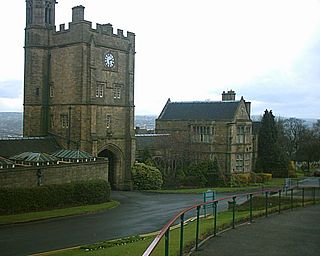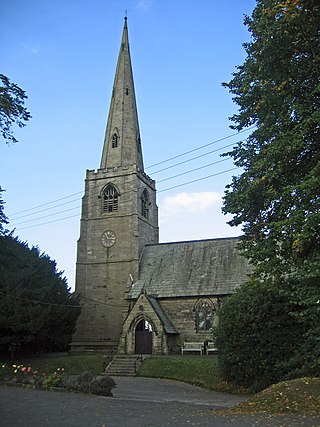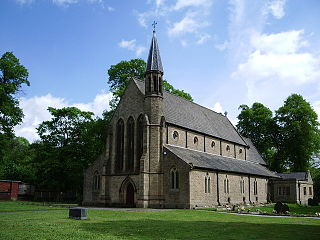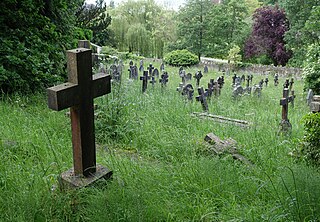
All Saints' Church, is in Childwall, Liverpool, England. It is recorded in the National Heritage List for England as a designated Grade I listed building, and is the only medieval church remaining in the Metropolitan borough of Liverpool. It is an active Anglican parish church in the diocese of Liverpool, the archdeaconry of Liverpool and the deanery of Liverpool South – Childwall.

Anfield Cemetery, or the City of Liverpool Cemetery, is located in Anfield, a district of Liverpool, Merseyside, England. It lies to the northeast of Stanley Park, and is bounded by Walton Lane to the west, Priory Road to the south, a railway line to the north, and the gardens of houses on Ince Avenue to the east. The cemetery grounds are included in the National Register of Historic Parks and Gardens at Grade II*.

The City Road Cemetery is a cemetery in the City of Sheffield, England that opened in May 1881 and was originally Intake Road Cemetery. Covering 100 acres (40 ha) it is the largest and is the head office for all the municipally owned cemeteries in Sheffield. The cemetery contains Sheffield Crematorium, whose first cremation was on 24 April 1905.

Warstone Lane Cemetery,, also called Brookfields Cemetery, Church of England Cemetery, or Mint Cemetery, is a cemetery dating from 1847 in Birmingham, England. It is one of two cemeteries in the city's Jewellery Quarter, in Hockley. It is no longer open to new burials.

St Pancras and Islington Cemetery is a cemetery in East Finchley, North London. Although it is situated in the London Borough of Barnet, it is run as two cemeteries, owned by two other London Boroughs, Camden and Islington. The fence along the boundary which runs west to east between the two parts of the cemetery has been removed, although the line of it is still marked.

St John the Evangelist's Church lies to the southeast of the village of Chelford, Cheshire, England. The church is recorded in the National Heritage List for England as a designated Grade II* listed building. It is an active Anglican parish church in the diocese of Chester, the archdeaconry of Macclesfield and the deanery of Knutsford. Its benefice is combined with that of St Peter, Lower Withington.

St John the Evangelist's Church is located to the north of the village of Ashton Hayes, Cheshire, England. It is an active Anglican parish church in the diocese of Chester, the archdeaconry of Chester and the deanery of Chester. The church is recorded in the National Heritage List for England as a designated Grade II listed building.

St Peter's Church is the parish church of Lymm in Warrington, Cheshire, England. The church is recorded in the National Heritage List for England as a designated Grade II listed building. It is an active Anglican parish church in the diocese of Chester, the archdeaconry of Macclesfield and the deanery of Bowdon. Its benefice is combined with that of St Werburgh, Warburton.
Spital is a suburb of the town of Chesterfield in the Borough of Chesterfield, Derbyshire, England. It is situated towards the east of Chesterfield town centre. The main road here is Spital Lane. With new estates being built, businesses include the Co-op, formerly the Spital Pub and Willbond(formally, Spital Tile Co.). Spital also has 2 parks one located at the top of Valley Road the other is along Spital Lane heading towards Calow Lane. Spital also has a cemetery. The Cemetery being one of the oldest walled garden cemeteries in Derbyshire.

The Lye and Wollescote Cemetery is an active 9.45 acres (3.82 ha) cemetery in Lye, West Midlands, England.

The church of St Laurence, Upminster, is the Church of England parish church in Upminster, England. It is a Grade I listed building. It is the historic minster or church from which Upminster derives its name, meaning 'upper church', probably signifying 'church on higher ground'. The place-name is first attested as 'Upmynster' in 1062, and appears as 'Upmunstra' in the Domesday Book of 1086.

St Leonards-on-Sea Congregational Church is a former Congregational church in St Leonards-on-Sea, part of the town and borough of Hastings in East Sussex, England. Considered "one of the most ambitious Nonconformist buildings in Sussex", the sandstone building of 1863 forms a significant landmark on one of the Victorian resort's main roads—despite the loss of its copper spire in the Great Storm of 1987. Unlike most churches of its denomination, it did not join the United Reformed Church when that denomination was formed in 1972. It fell out of religious use in 2008 and had stood empty and was at risk of demolition. English Heritage has listed the building at Grade II for its architectural and historical importance. Bought by a new owner in 2012 it was almost completely renovated, but was then sold again in 2019. The new owner plans to open the church to the public as an arts and antiques centre with a cafe in the tower.

St Saviour's Church is in Ringley, Kearsley, near Bolton, Greater Manchester, England. It is an active Anglican parish church in the deanery of Bolton, the archdeaconry of Bolton and the diocese of Manchester. Its benefice is united with those of St Peter's, Farnworth, St John the Evangelist, Farnworth and Holy Trinity, Prestolee. The church is recorded in the National Heritage List for England as a designated Grade II listed building.

The English coastal city of Brighton and Hove, made up of the formerly separate Boroughs of Brighton and Hove in East Sussex, has a wide range of cemeteries throughout its urban area. Many were established in the mid-19th century, a time in which the Victorian "cult of death" encouraged extravagant, expensive memorials set in carefully cultivated landscapes which were even recommended as tourist attractions. Some of the largest, such as the Extra Mural Cemetery and the Brighton and Preston Cemetery, were set in particularly impressive natural landscapes. Brighton and Hove City Council, the local authority responsible for public services in the city, manages seven cemeteries, one of which also has the city's main crematorium. An eighth cemetery and a second crematorium are owned by a private company. Many cemeteries are full and no longer accept new burials. The council maintains administrative offices and a mortuary at the Woodvale Cemetery, and employs a coroner and support staff.
Weaste Cemetery is a public cemetery in Weaste, Salford, Greater Manchester, in England. Opened in 1857, it is the oldest of Salford's four cemeteries, covering 39 acres and containing over 332,000 graves.

Smallcombe Cemetery is on the edge of Bath, Somerset, England, in a valley between Widcombe Hill and Bathwick Hill. It has two distinct parts, the Anglican section known as St Mary's Churchyard and the nonconformist section known as Smallcombe Vale cemetery; they are sometimes known together as Smallcombe Garden cemetery. The two cemeteries have been closed to new burials since 1988 and are maintained by Bath and North East Somerset Council. The Bath Corporation had assumed responsibility for both cemeteries in 1947.

Richmond Cemetery is a cemetery on Lower Grove Road in Richmond in the London Borough of Richmond upon Thames, England. The cemetery opened in 1786 on a plot of land granted by an Act of Parliament the previous year. The cemetery has been expanded several times and now occupies a 15-acre (6-hectare) site which, prior to the expansion of London, was a rural area of Surrey. It is bounded to the east by Richmond Park and to the north by East Sheen Cemetery, with which it is now contiguous and whose chapel is used for services by both cemeteries. Richmond cemetery originally contained two chapels—one Anglican and one Nonconformist—both built in the Gothic revival style, but both are now privately owned and the Nonconformist chapel today falls outside the cemetery walls after a redrawing of its boundaries.

Tiverton Cemetery is the burial ground for the town of Tiverton in Devon. The cemetery covers eight acres and is owned and maintained by Mid Devon Council.

Townsend Cemetery is a cemetery in Crewkerne, Somerset, England. It is owned by Crewkerne Town Council, and jointly run by the Town Council and West Crewkerne Parish Council.


















